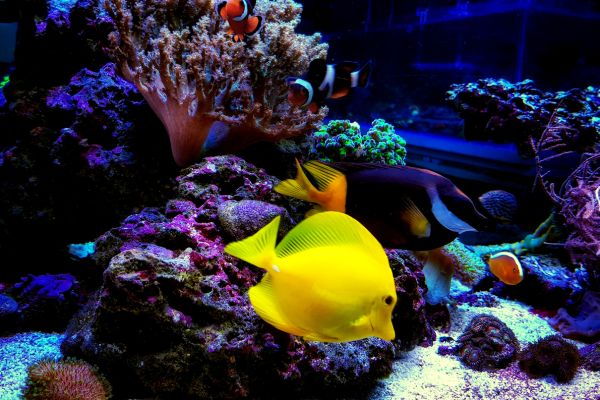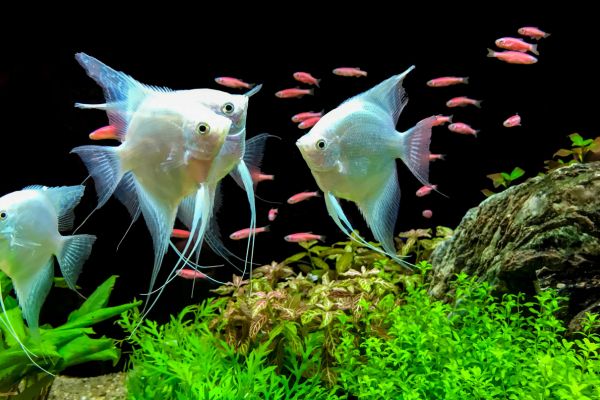You probably already know that fish living in the ocean can’t survive in freshwater lakes and rivers and vice versa. After all, they have radically different needs, which goes beyond how much salt is in their water. For fish tank hobbyists, it may go without saying that you need to pick one type of tank and stock it with appropriate species that will thrive in those conditions. But which is right for you in the debate between a saltwater vs. freshwater aquarium?
Today, we’ll share the many differences between these two types of tanks so you can make the best decision for your unique needs and preferences. You can also learn more about our custom tanks, perfect for saltwater or freshwater aquarium builds, by clicking the button below.
Saltwater vs. Freshwater Aquariums: Startup Costs
The first thing someone picking up any new hobby will consider is how much of an investment it will be. In this regard, there are some critical differences between freshwater and saltwater tanks for you to note.
The first thing contributing to the aquarium’s cost is the organisms you’ll fill it with. Here, there’s a pretty clear disparity in pricing.
Costs of Fish and Plants
Many freshwater fish cost $5 or less. For example, bettas and goldfish cost about $3, while you can get tetras and gouramis for about $3. Cichlids are a little more expensive, at $5. Aquarium plants for your freshwater tank will also be affordable, generally in the $2 to $24 range.
On the other hand, saltwater fish can cost far more. Prices range from $15 for dottybacks and $20 for blennies to $30 for clownfish. Butterflyfish can cost about $75! Saltwater plants and coral will be more expensive than their freshwater counterparts, generally between $50 and $250.
Tank and Equipment
Saltwater aquariums require more equipment, which contributes to higher startup costs. Factoring in the tank itself, the gravel to use as a substrate, a power filter, a regular fluorescent aquarium light, food, nets, scrapers, a quarantine tank, and test kits for pH, ammonia, nitrite, and nitrate, the total startup cost for a reasonable freshwater aquarium totals about $270.
A saltwater aquarium also requires power Heads for water movement, a protein skimmer, a hydrometer, salt mix, live rock, sand (a more expensive substrate than gravel), and additional test kits for calcium levels and alkalinity. This puts the total for a saltwater tank at approximately $635—and if you decide to create a reef tank, it’ll be twice as much.
Of course, there are always ways you can invest in your freshwater tank and bring it up to prices comparable to a saltwater tank—for example, if you have a lot of plants, you’ll spend more on lighting and fertilizer. And if you have some experience, you can probably find DIY solutions to many of the equipment expenses for saltwater tanks.

Saltwater vs. Freshwater Aquarium Maintenance
What is easier: a saltwater or freshwater aquarium? Usually, that would be a freshwater aquarium. Why?
All the extra equipment needed for saltwater tanks needs additional maintenance and care to keep it functioning correctly. Plus, there’s the work of making your saltwater aquarium, well… salty.
Before changing water, you need to let salts dissolve in the water for days beforehand. The salt dissolves slowly, and you need to check the salinity with a hydrometer. You could make the process easier by setting up a system where the water is continuously mixed in a large bucket, a heater heats it, and a powerhead circulates it. But putting that together takes time and effort as well. You can buy saltwater from a supply store, but that adds to the cost of saltwater aquarium maintenance.
In addition to that, you need to keep a closer eye on the more sensitive organisms in a saltwater tank. There are more water tests to be done, and you need to watch out for “stowaway” organisms that often come along with the live rocks and sand that you should add to saltwater tanks. Some of these can positively contribute to an evolving tank but require treatment changes, while others can be harmful and require removal.
On the other hand, freshwater tank maintenance is much more straightforward. When done properly, water changes don’t require steps beyond what a beginner tank hobbyist would expect. There’s also less “surprise elements” to watch for, making it more hands-off.

The Element of Unpredictability
Saltwater organisms are generally more sensitive to water salinity, calcium, heat, and light. The sheer range of available organism types is much more extensive for saltwater tanks. Examples include corals, cephalopods, mollusks, crustaceans, and more.
Curating a collection of organisms compatible with one another and needing similar aquarium conditions—and then delivering an environment where they can all flourish—is a complex and delicate task. You never know when two fish will be aggressive toward one another or when one fish won’t want to share the reef space or the food because you haven’t supplied enough.
A freshwater aquarium is generally a better option for someone’s first aquarium. Starting small is an excellent way to develop your expertise before you go on to tackle the more complicated, pricier, riskier challenge of a saltwater aquarium.
But we’d be dishonest if we didn’t admit that saltwater aquariums reward you for the extra time, effort, and investment. Saltwater aquarium maintenance can be a pain. But it’s all worth it when you get to enjoy the brilliant, active sight of a well-designed and well-maintained saltwater aquarium. That diversity can create brilliant splashes of color and exciting dynamics between livestock, which you can’t quite replicate with a freshwater aquarium.
Freshwater vs. Saltwater Fish Tank: Which Will You Choose?
Whether you’re starting with a freshwater tank or are ready to take on saltwater aquarium maintenance, you’ll need an expert to help you get set up. Living Art Aquatics has been designing residential and commercial aquariums for over twenty years. We’ll even install your aquarium and help you maintain it if you need help. For us, aquariums are more than a hobby—it’s living art.
Editor’s Note: This blog was originally published in August of 2016 and updated in February of 2024.





